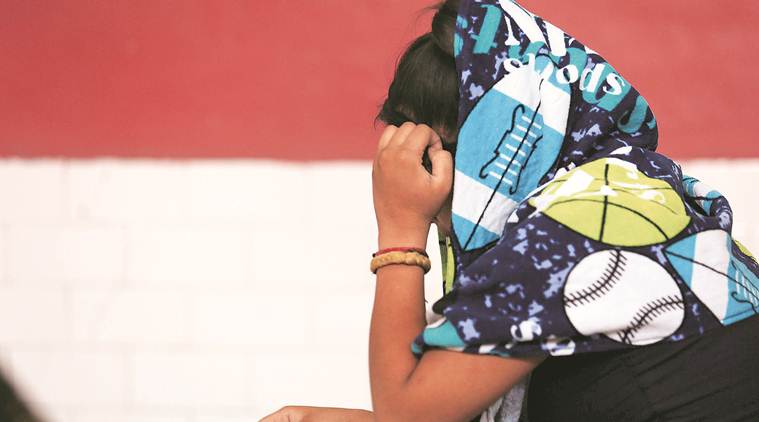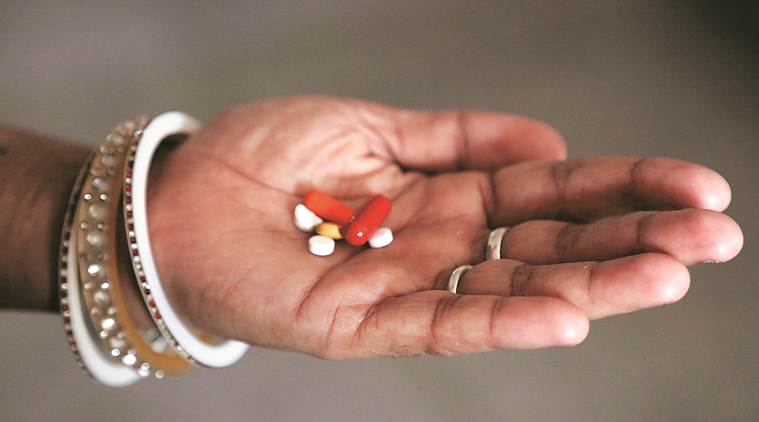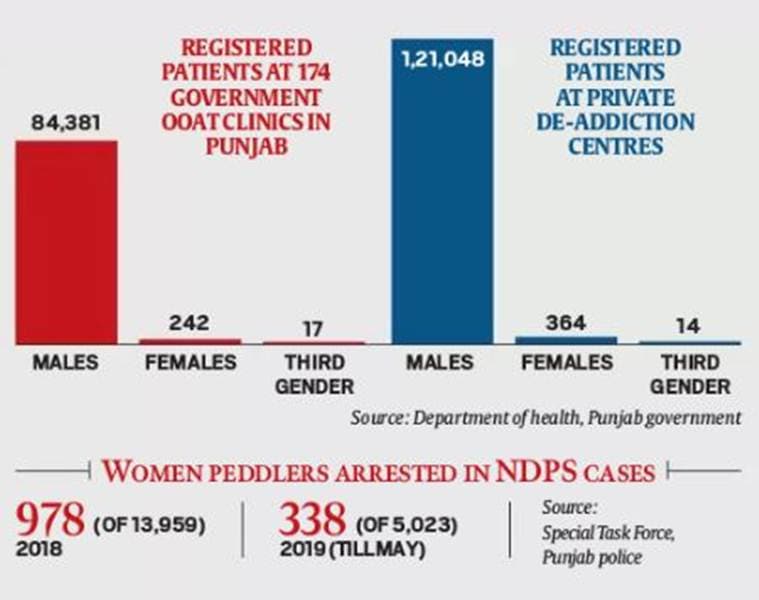
Harjot Kaur has no idea whether her husband is dead or alive. “Ki pata poora ho gaya hova (he might have died),” says the 30-year-old, disdain dripping from her words.
The couple had a bitter fight one day and he broke her arm. “I was writhing in pain. He gave me chitta (heroin) saying it was a pain reliever. An illiterate, I believed him,” she says.
He was a drug addict. She too was soon hooked. “Initially we used to take pure heroin. Then there was no money to buy it. Then we started injecting cheap white powder mixed with water, at least five times a day. We mortgaged our home to buy drugs. It cost us everything,” Harjot adds.
The husband then took to petty thefts and snatchings to fund his addiction. “He spent three years in jail,” she says. So intense was her addiction that she doesn’t even remember when exactly her husband went missing and never returned home.
Harjot is one of the patients admitted to Punjab’s only government run de-addiction centre for women – Navkiran Kendra – in the premises of Kapurthala Civil Hospital.
The biggest victim of Harjot and her husband’s drug addiction is their daughter. The parents never admitted her to school and she grew up seeing them injecting drugs in their veins. Now 7, she lives with Harjot at the centre and has been admitted to a school by the administration.
Call it government’s lack of vision or failure to accept that women too take to drugs, In Punjab’s narcotics problem scenario, women addicts have largely remained ignored. This, mostly because women refuse to go for treatment fearing social stigma. While Punjab’s drug problem has remained in focus for more than a decade now, it was only in 2018 that government realized the need for a de-addiction centre exclusively for women and set up the 15-bed Navkiran Kendra. However, there are some private and government centres where both men and women are treated.

So, what exactly is pushing women into this trap?
According to experts, there are several reasons but at the top is the influence of the male partner, who more often than not happens to be an addict in most such cases.
“Mostly it is the male partner under whose influence a woman starts taking drugs. There are relationship issues, broken marriages, domestic violence, alcohol addiction, peer pressure (among students) and some get into addiction while selling drugs for easy money or for running their household if the male partner is unemployed. Women in flesh trade often take to drugs when they start feeling guilty. Among students, it starts with party drugs,” says Dr Sandeep Bhola, consultant psychiatrist, de-addiction specialist and incharge, Navkiran Kendra. He adds that among opioid drugs, women patients are mostly addicted to heroin.
Read | Against drugs, setting the wheels in motion
Take the case of 19-year old Shivani from Ludhiana. The girl who cleared class 12 board exams this year, is undergoing treatment for heroin addiction. “My boyfriend of two years ended the relationship to be with some other girl. It was before the board exams. I was emotionally drained and angry. A friend suggested that I take a hit to relieve the pain. That was the first time I snorted heroin using a wrap (panni),” Shivani recalls.
“I used to get Rs 2,000 a week for pocket money and I would get half a gram heroin, which I used to manage with for seven days. One day my mother caught me doing drugs in the washroom. My boyfriend wasn’t an addict, but I ruined my life in a momentary act of foolishness,” she says. Shivani now wants to pursue graduation but her parents fear she will again take to drugs in college.
Twenty-eight year old Gurjot Kaur started doing drugs after her husband offered her heroin as a pain killer for headache. “He said I will feel better. I was hooked and kept injecting heroin for almost 10 years,” says Gurjot. Her husband died of drug overdose a year ago and some family members brought her to Navkiran for treatment.
Manjeet (25) snorted heroin a few times with friends just for fun. She turned into an addict soon. Following a broken marriage, Manjeet enrolled into a beautician’s course. “Girls there used to take drugs. I took heroin for some days with them and then became an addict. For three years, I injected myself 7-8 times a day. Me and my friend used to get a 12 ml bottle, which was enough for two persons. We used to buy it for Rs 100 and then further sell it also for Rs 600 to get money for our own drugs. From heroin to several other medical drugs, I injected all,” says Manjeet, now a Hepatitis-C patient.
Women in drug trade
Chief of the Anti-drug Special Task Force (STF), Additional Director General of Police (ADGP) Gurpreet Kaur Deo says that a woman becoming an addict affects the entire family. “If a man goes astray, a woman can guide the family. But if a woman becomes an addict, she is vulnerable to sexual and physical exploitation and unable to guide her children. Fearing social stigma, they are afraid to declare their addiction. Women addicts are hardly visiting Outpatient Opioid Assisted Treatment (OOAT) centres for treatment due to stigma”.
Based on the arrests made, the ADGP adds that women peddlers get into drug trade for easy money, running the household if the male partner was unemployed or if they themselves were hooked to drugs.
Read | Punjab: Biggest ever haul puts spotlight on ‘new’ drug route, modus operandi

Door to door survey to treat women addicts: Minister
Punjab Health Minister Balbir Singh Sidhu says that soon ASHA workers will be conducting door to door surveys in villages to treat women addicts. “ASHA workers will be going door to door and treatment given to women addicts will be confidential. They will be provided medicines at doorsteps to avoid social embarrassment. We planned this project because a woman can open up with a woman. Currently there is no need to open more women exclusive de-addiction centres. Identifying women addicts is more important,” he says.
“Initially, the priority was to provide enough treatment facilities for men as they constitute majority of addicts,” he adds.
Drug addiction among women in Punjab in numbers
Though there is no data available with the government stating exact number of female addicts in state, the statistics compiled and accessed by The Indian Express, show that a significant number of women in Punjab are hooked to drugs and problem cannot be ignored.
Since Navkiran Kendra was opened last year, 53 women addicts have been admitted there. A new project – comprehensive health and rights based approach for women who use drugs — was started in February this year under which 106 people have been registered of which maximum are 20-35 years of age. Six were tested HIV positive and 17 HCV positive.
The study ‘Punjab Opioid Dependence Survey: Estimation of the Size of Opioid Dependent Population in Punjab’ conducted by AIIMS, Delhi in 2015-16, pegged opioid dependents at 1.2 per cent of adult population in state (approx 2.32 lakh individuals in 18-35 age group). It said that ’99 per cent of opioid users were males’, indicating rest one per cent were females.
Read | Punjab: Village-level distribution, women peddlers keep cops on toes

Magnitude of Substance Use in India-2019 report
Though conducted at national level by AIIMS and National Drug Dependence Treatment Centre, the findings give an idea of addiction problem among women in Punjab. Study was conducted for age group 10-75 years across all states and UTs. Findings:
* For every one woman who consumes alcohol in India, there are 17 alcohol consuming men. Punjab is among five states with highest alcohol consumers.
Cannabis users (ganja, charas, bhang): 2.8 per cent of total population use cannabis of which 0.6% are females, 0.9% children (10-17 years) and 5% males. Punjab among the five states with the higher-than-national prevalence of cannabis users.
Opioid users (heroin, poppy husk, opium, pharmaceuticals): 2.1% of total population use opioid drugs of which 0.2% are females, 1.8 % children and 4% males. Of top ten states where people need help for opioid related problems, Punjab has the second highest 7.2 lakh persons after Uttar Pradesh (10.7 lakh)
Cocaine users: Study says that 0.18% males and 0.01% females in the country are using cocaine but Punjab having second highest (27,000 approx) cocaine users.
People Who Inject Drugs (PWIDs): Of estimated 8.5 lakh PWIDs, the second highest 88,000 in Punjab.
(Note: Names of all the patients interviewed have been changed to protect their identities)